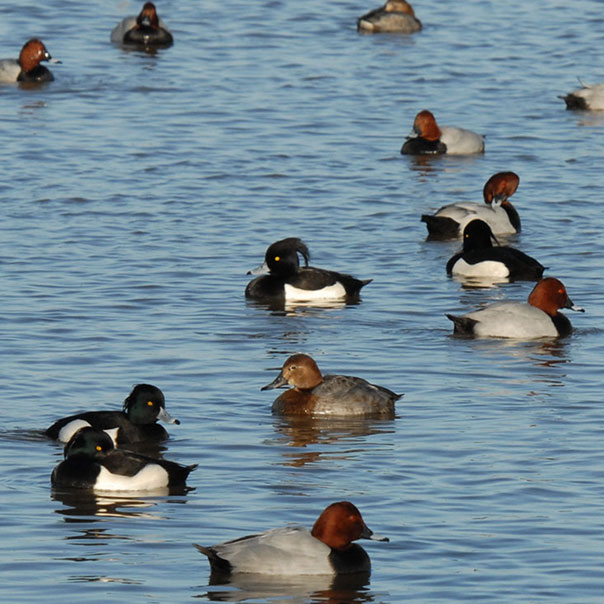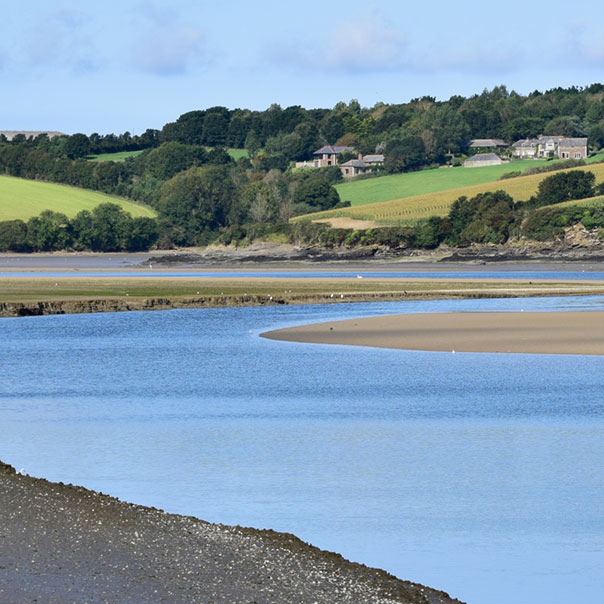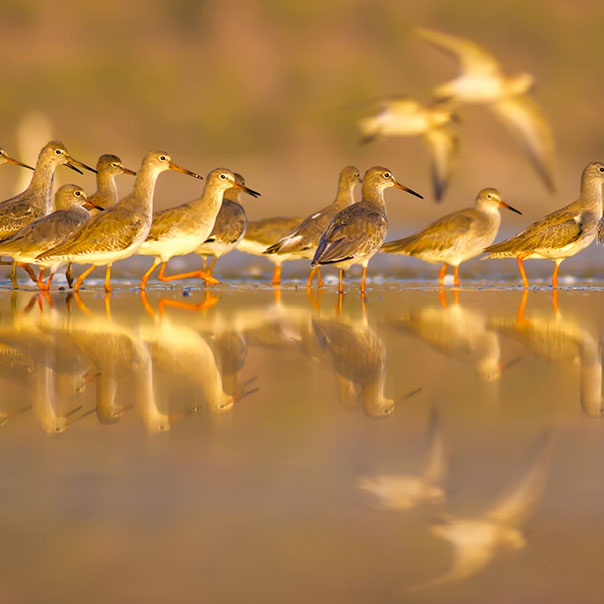Wetland wildlife in December
The cold weather is here and with it, birds in their thousands are congregating en masse at our wetlands, using the habitat as a relatively warm refuge in which to rest and feed together.
Waterbirds of all shapes and sizes can be spotted on our wetlands this month; it’s time to dig out your hat and gloves and join them.
Set in for the winter
In recent weeks, duck numbers will have been building and many species can now be spotted at a wetland near you. One truly special sight are the armies of wigeon, grazing on short grass around pools as they march away from the water as a group, making whistling calls to stay in contact. But they aren’t quite so brave as they seem; once spooked, they’ll all fly up as one, with a loud skiffle of wings, back to the safety of the water. Another interesting duck behaviour to watch out for are the feeding groups of shoveler, with their large, spatulate bills firmly underwater whilst their bodies whirl round and round to disturb invertebrates. You might also notice teal inhabiting the edges of pools and wet woodland; this small duck is able to exploit every feeding opportunity.
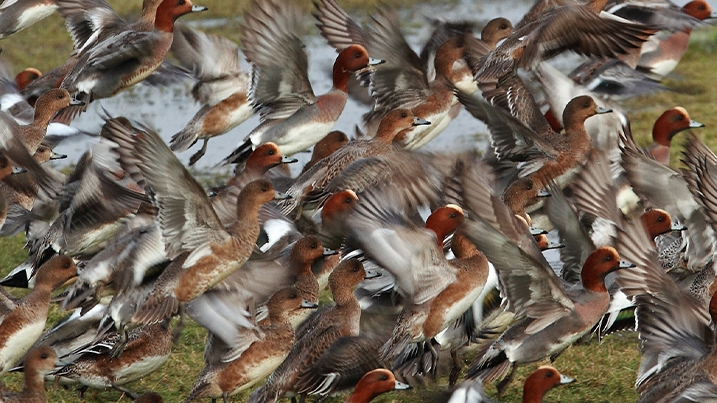
Wintering waders are another must-see spectacle. On our shorelines and estuaries, they are congregating in huge flocks. Look out for species such as knot, godwit, golden plover, dunlin and lapwing putting on a stunning aerial display.
Numbers of whooper swan will now likely be at their peak, with WWT Welney and the surrounding Ouse Washes regularly recording over 10,000 individuals; a sure sign that the Icelandic breeding population is currently doing very well. You’re also now in with a good chance of seeing the Bewick’s swan, along with several species of geese. But sadly in recent years, we are experiencing fewer individuals arriving for winter, mostly due to our milder climate. Birds are short-stopping as they can stay on in mainland Europe and keep warm and simply don’t need to cross the North Sea. This is particularly true of bean geese and white-fronted geese. For example, Russian white-fronts wintering at Slimbridge used to number in their thousands, but numbers now peak in the low hundreds.
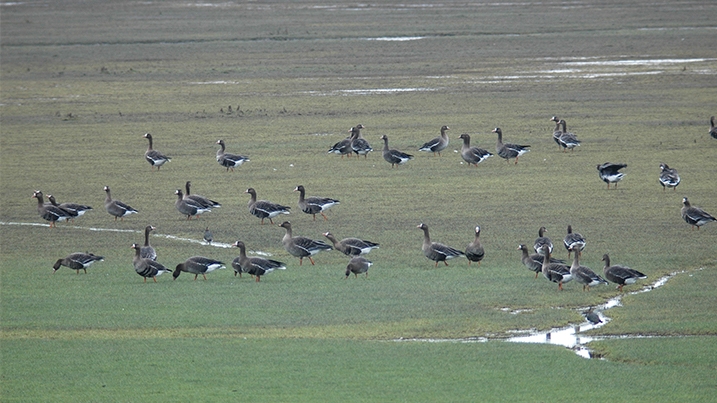
Those birds that do make it to winter on our wetlands will hopefully have brought their offspring with them on the journey from their breeding grounds in the far north. When you’re taking a look at groups of geese and swans this month, spend some time trying to spot the juveniles. For the large grey geese such as greylag, pink-footed, bean and white-fronted, the young geese sport much plainer plumage than the adults, who have pale fringes to the feathers on their back. The reverse is true in barnacle and brent geese. The ratio of young birds to adults will give you an impression of how good the breeding season has been. Many geese and swan families will stay together for the winter, largely staying put and eating as much as they can to stay warm.
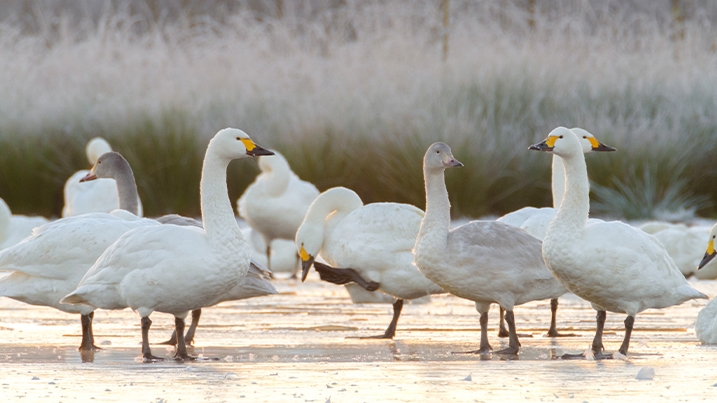
Aerial predators
The winter season is great for taking time to see birds of prey. Indeed, short eared owls can often be seen hunting in the mid-afternoon sunshine over wet meadows and saltmarsh, searching for voles. Falcons are likely to be seen too, such as peregrine and merlin, as they wheel over the marshes, expertly giving chase to anything they think worth their energy. The peregrine can take anything up to the size of a large wader, whilst the merlin, as our smallest raptor, will usually stick to smaller fare.
Often high on the agenda of an agile falcon will be to try their luck with pursuing a starling. However, the starlings are well aware of the danger and as they come into their reedbed roost at dusk, they form tight flocks known as a murmuration, which can number many thousands of individual birds. It’s a stunning spectacle for us but for the falcons it is confusing and means they find it very tricky to pick out individual prey. Take a walk down to a reedbed near you at dusk this month; you might well have a starling roost on your doorstep.
The marshes can also play host to wintering harriers. Some of us will be familiar with marsh harriers over the reedbeds, but a lucky few might get a glimpse of a hen harrier. A white ‘ringtail’ on a brown bird notes a female or juvenile, whilst ghostly grey plumage is diagnostic of the male.
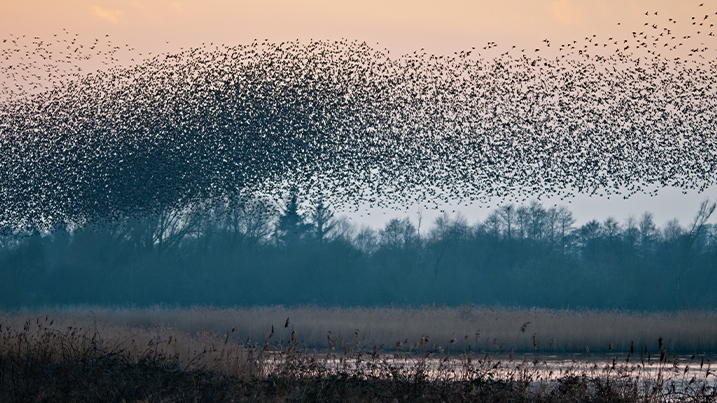
Where to see December wildlife
Our wintering duck species can be seen up and down the country and could easily turn up at a wetland near you. Teal especially can be found in unlikely places such as a flood storage area, if you look closely enough.
The above-mentioned raptors could be seen at wetlands across the country. It’s a similar story with their wintering wader prey.
Whooper swans can be seen at WWT Caerlaverock, Martin Mere and Welney, whilst Bewick’s swans can be seen at Slimbridge and Welney, whereas bean geese and Russian white-fronts can typically be seen in more eastern areas.
Find your nearest WWT wetland siteJanuary
Next time, we’ll be in to January, with many more opportunities to see winter wetland wildlife to come; an ideal time to get out and see wildlife in the short daylight hours.
Wetland wildlife in JanuarySupport from players of People's Postcode Lottery helps us care for our reserves and protect amazing wetland wildlife.

